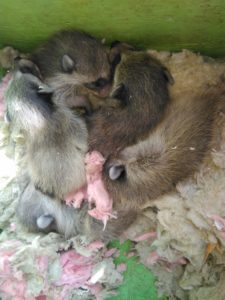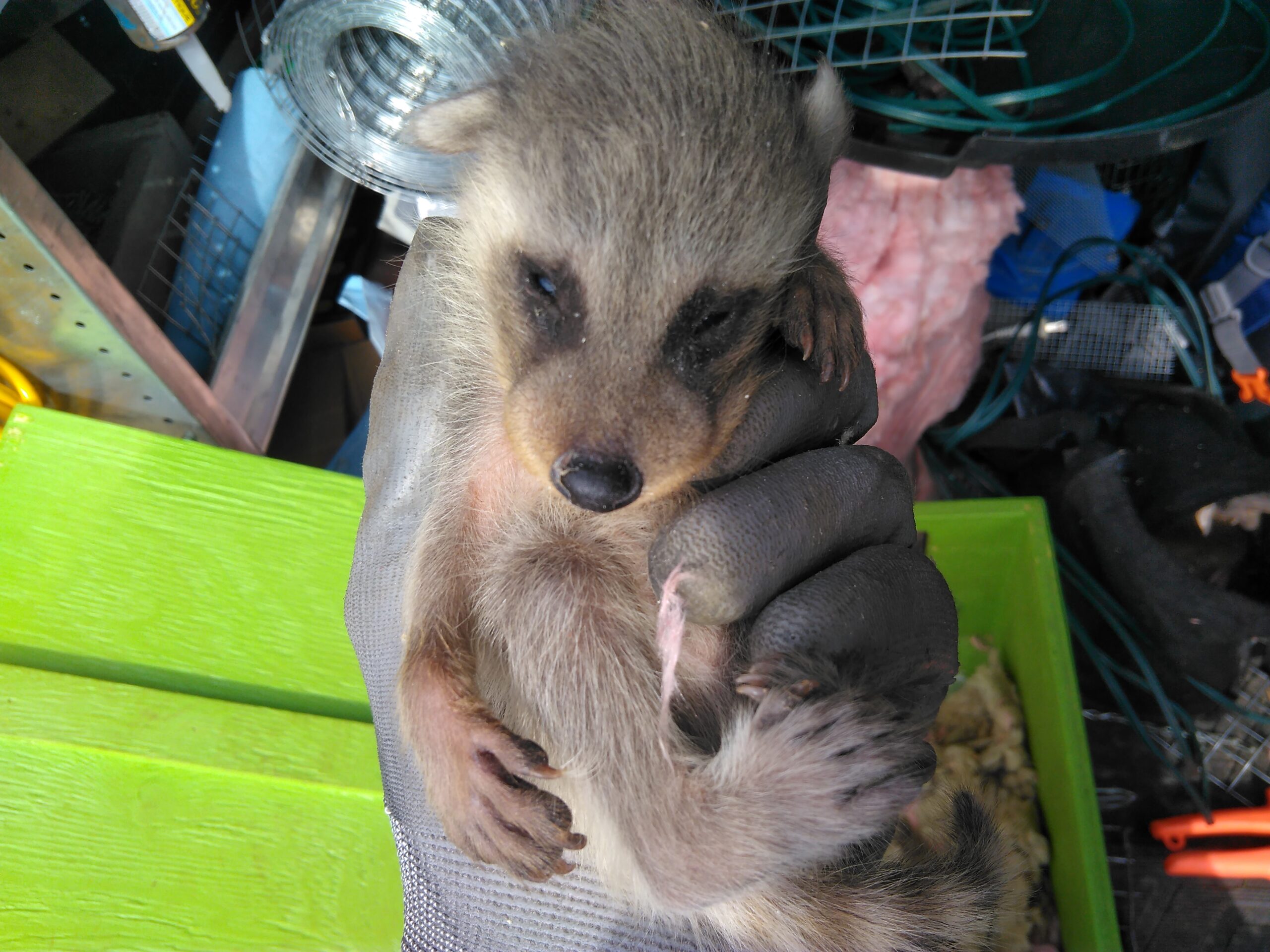Conversation with Alex Boyer, Skedaddle Montreal
How did the homeowner first realize there were babies in the attic? How did you know the raccoon had returned to a home she had previously denned in? This particular homeowner had experienced issues in the past with a raccoon that simply refused to den elsewhere. Approximately three to four years ago, the raccoon was successfully removed from the insulation above his garage, and the location was completely sealed off to prevent her from re-entering. This spring, to the homeowner's surprise, he woke up to screeching sounds again from above his garage. How many did you find? Where did you find them? After a visual inspection, our Skedaddle team had noticed the siding was completely ripped apart on the side of the home. Since there was no wood behind the siding, the raccoon had a clear shot into the attic. Upon the homeowner's suggestion of where the sounds were coming from, we were able to find them in the lower attic. What did you do to remove them and prevent them from coming back? After safely removing all the babies and placing them in the baby box, we installed a one-way door for the mother raccoon. We came back the next morning and the mother raccoon was still in the attic, with one more baby! She later exited the home and relocated her babies. Our team screened off the entire siding 3 feet down from the roof to ensure she didn’t try to re-enter this gentleman's home.Training for Skedaddle Wildlife Techs
For Skedaddle Wildlife Technicians, spring is the busiest and most exciting season. It is rewarding for technicians to remove the babies successfully and then watch as their mothers reunite with them and carry them away to a new home. Nevertheless, the satisfaction of this moment must be earned. Before Skedaddle Techs go out into the field for their first raccoon removal, they undergo extensive training. This involves learning how to perform a thorough search of all the inaccessible, out-of-the-way locations where the mother raccoon may hide her babies, as well as treating the mother and her babies with respect. Mother raccoons understand instinctively how helpless their babies are and can be very aggressive in defending them. Raccoons can also be infected with rabies without showing any symptoms. For these reasons, it is very important that our technicians receive training to retain control of the situation when faced with the raccoon mother. The key to this is often remaining calm. Because it is so important for our technicians to use care in handling a situation involving baby animals, our training is not just reserved for new hires. All of our technicians go through a spring tune-up every year prior to baby season. Safe, effective baby searches are the focus of this day-long training session, helping even experienced techs improve their skills at searching and removal. [embed]https://www.youtube.com/watch?v=vntrnurHejA[/embed]Finding Offspring and Using Baby Boxes To Reunite Families
Even within the relative protection of an attic, mother raccoons take no chances when it comes to protecting their babies. They often hide the kits within wall cavities, soffits, dark corners, and other hard-to-reach recesses. Our technicians' ears can be just as important as their eyes in locating raccoon babies, which often make high-pitched noises described as crying, mewing, whining, and cooing. Training and experience has taught our techs where to look for raccoon babies and how to cope with the challenge of persevering in a search that may be dark, dirty, and hot. The only way to remove raccoon babies from a human habitation is by hand. Raccoon kits are too small and weak to leave on their own if someone tries to chase them out. Depending on their age, they may also be entirely deaf and blind. After all the babies have been removed from the home, the next step is to place them where the mother raccoon can find them. She will often have several other dens in the vicinity, and once she finds that she can no longer access her preferred den, she will locate the babies somewhere else. A wooden baby box is only a temporary shelter, not a new den. Its purpose is to protect the litter of kits from predators and the elements, keeping them all in one place until the mother finds them and starts to relocate them. The mother raccoon performs the relocation according to her own time frame. Some are so anxious about their babies that they start relocating them even before the removal is completed. Then again, because raccoons are nocturnal creatures, some are more comfortable waiting until nightfall and relocating their babies under the cover of darkness.
Regardless of when the mother raccoon decides to relocate her babies to the new den, the baby box will protect the kits until she does. It is placed near the point of entry by which the mother raccoon initially gained access to the site. This ensures that the mother will be able to find them easily. It is heated and lined with soft nesting material so that the babies remain safe and warm until their mother finds them and decides to move them elsewhere. If the mother raccoon is still in the den when the technicians remove the babies, they will not try to disturb her. Rather, they will install a one-way door over the entry point that allows the raccoon to exit but not to re-enter.
As you can see from the video, once the mother raccoon locates her babies, she will initially attempt to carry them back into the den. However, once she realizes that her entryway has been blocked, she will give up the attempt and start moving her babies elsewhere. The mother raccoon carries each baby in her mouth like a mother cat with her kittens. She transports them one at a time and then comes back for the others.
A wooden baby box is only a temporary shelter, not a new den. Its purpose is to protect the litter of kits from predators and the elements, keeping them all in one place until the mother finds them and starts to relocate them. The mother raccoon performs the relocation according to her own time frame. Some are so anxious about their babies that they start relocating them even before the removal is completed. Then again, because raccoons are nocturnal creatures, some are more comfortable waiting until nightfall and relocating their babies under the cover of darkness.
Regardless of when the mother raccoon decides to relocate her babies to the new den, the baby box will protect the kits until she does. It is placed near the point of entry by which the mother raccoon initially gained access to the site. This ensures that the mother will be able to find them easily. It is heated and lined with soft nesting material so that the babies remain safe and warm until their mother finds them and decides to move them elsewhere. If the mother raccoon is still in the den when the technicians remove the babies, they will not try to disturb her. Rather, they will install a one-way door over the entry point that allows the raccoon to exit but not to re-enter.
As you can see from the video, once the mother raccoon locates her babies, she will initially attempt to carry them back into the den. However, once she realizes that her entryway has been blocked, she will give up the attempt and start moving her babies elsewhere. The mother raccoon carries each baby in her mouth like a mother cat with her kittens. She transports them one at a time and then comes back for the others.



